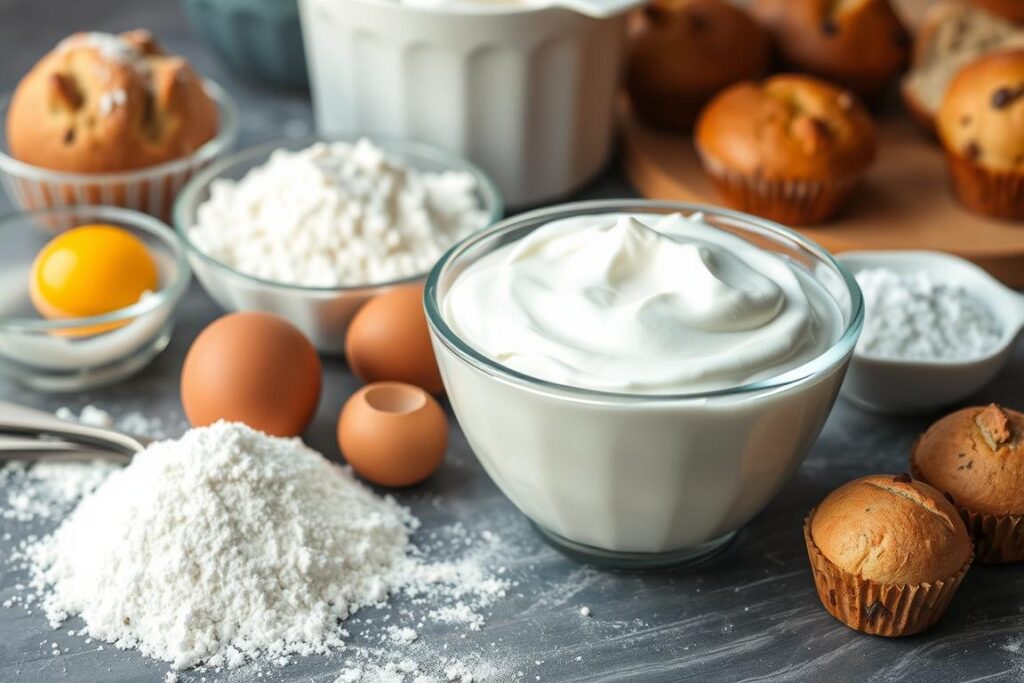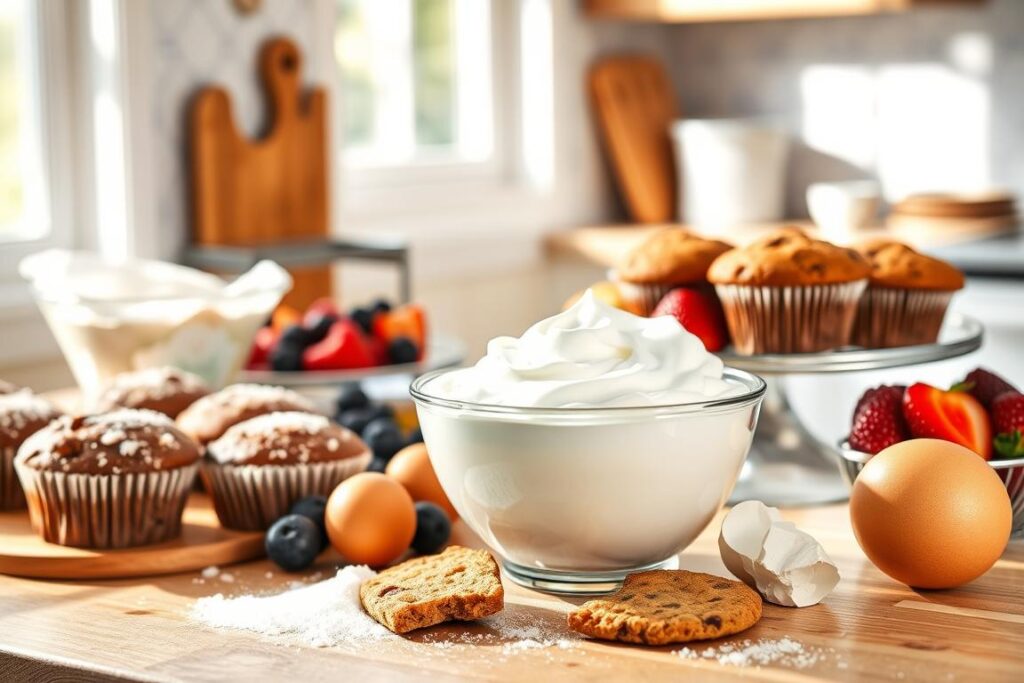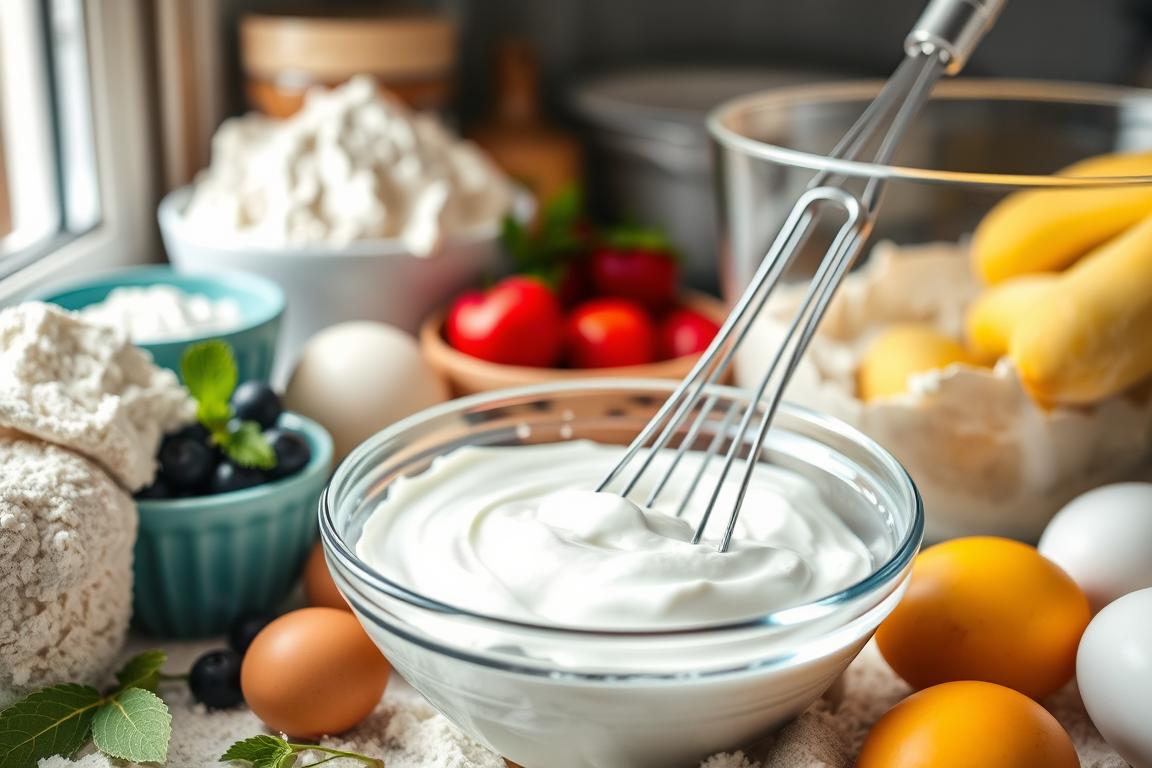Every kitchen has a secret that makes baking special. For me, that secret is Greek yogurt. It changed my baking, making cakes light and moist.
Greek yogurt baking is more than a trend. It’s a way to make healthier, tastier treats. Knowing how Greek yogurt affects baking opens up new possibilities in your kitchen.
Think about making your favorite cake better with just one change. Professional chefs use Greek yogurt for its texture, flavor, and nutrition. It’s a secret ingredient for bakers.
Greek yogurt makes muffins tender and cakes rich. Its protein and acidity make baked goods lighter yet more satisfying.
What is the Effect of Greek Yogurt in Baking?
Greek yogurt changes baking in big ways. It adds special chemical properties that make your recipes better. Using it as a substitute brings a powerful ingredient that boosts both taste and health.

Adding yogurt to your baking brings many benefits. Its high protein content makes baked goods tender and moist. This is a big plus for your treats.
Chemical Properties and Protein Impact
Greek yogurt’s special chemical makeup offers great benefits. Its protein helps in several ways:
- It makes cakes and muffins more tender
- It keeps baked goods moist
- It strengthens the structure of your treats
Fat and Moisture Dynamics
The fat in Greek yogurt is key for tasty baked goods. Replacing regular fats with yogurt makes your treats healthier. And they don’t lose their flavor.
Texture and Moisture Considerations
Using Greek yogurt in baking keeps your treats moist. Its water content stops them from drying out. This ensures your baked goods stay soft and enjoyable.
Benefits of Using Greek Yogurt as a Substitute in Baked Goods

Greek yogurt has changed baking for the better. It’s a healthier and more flexible choice for your recipes. It makes baked goods more nutritious and with a better texture.
Using Greek yogurt in baking has many benefits. It has about 17 grams of protein per serving. This is more than regular ingredients. Here are some key benefits:
- Reduces overall fat content in baked goods
- Adds moisture and richness to cakes, muffins, and breads
- Provides natural tanginess and depth of flavor
- Enhances protein content compared to regular ingredients
Switching to Greek yogurt is easy. You can swap sour cream, buttermilk, and some oils or butters with it. This change makes your baked goods healthier and tastier.
Professional bakers love Greek yogurt for its flexibility. It makes baked goods lighter and more tender. It keeps them moist. Greek yogurt is great for baking cookies, cakes, or quick breads.
How Greek Yogurt Affects Dough Structure and Gluten Development
Adding Greek yogurt to your baking changes the dough’s structure. Its unique proteins help form gluten and improve baking results.
Knowing how Greek yogurt works with flour is essential for great baked goods. Its protein content boosts dough’s elasticity and gluten formation.
Protein Content and Gluten Formation
Greek yogurt adds special properties to your baked goods. Its high protein content helps gluten develop by:
- Adding moisture to the dough
- Improving protein interaction
- Making dough 15% more elastic
Impact on Dough Elasticity
Greek yogurt and flour mix to create a complex dough. Kneading makes the dough softer and more textured.
Temperature Considerations
Temperature is key when baking with Greek yogurt. Remember these tips:
- Use room temperature yogurt for best mixing
- Avoid overheating to preserve protein
- Keep dough temperature steady
Understanding these points helps you make tender, tasty, and well-structured baked goods with Greek yogurt.
Moisture Retention and Texture Enhancement in Baked Products
Greek yogurt changes how you bake by adding moisture to your treats. It makes your baked goods soft and rich, like a pro’s. Adding Greek yogurt to your recipes makes a big difference in how they turn out.
The magic of Greek yogurt in baking is its high protein content. These proteins work with other ingredients to make your baked goods tender and moist. Using Greek yogurt instead of fat makes your treats:
- Softer cake textures
- Enhanced moisture retention
- Reduced overall fat content
- Improved baked goods longevity
Bakers love Greek yogurt for keeping their baked goods moist. You can replace oil with Greek yogurt in a 1:1 ratio. This makes your baked goods fluffier and tastier. To avoid drying them out, bake at a lower temperature and for a bit longer.
Swapping out traditional fats for Greek yogurt is a game-changer. It makes your baked goods healthier and more delicious. The protein in yogurt not only improves texture but also boosts nutrition.
Chemical Reactions Between Greek Yogurt and Leavening Agents
Greek yogurt adds a scientific twist to baking. It has unique properties that react with leavening agents. This can change your baked goods in amazing ways.
When you mix yogurt with baking powder and soda, cool things happen. The yogurt’s acidity works with these agents. This mix is key to making your baked goods light and fluffy.
Interaction with Baking Powder
The acid in yogurt starts a reaction with baking powder. Here’s what happens:
- Acid in yogurt activates baking powder’s rising mechanism
- Minimum baking powder needed: approximately 3 grams
- Creates gas bubbles that help dough expand
Effects on Rising and Volume
The mix of yogurt and leavening agents changes your baked goods. Baking with yogurt can:
- Increase cake height and lightness
- Improve overall product structure
- Create more consistent rising patterns
pH Balance and Acidity Levels
Knowing your ingredients’ pH levels is key for baking. Greek yogurt, being less acidic than flavored types, affects how it works with leavening agents.
By balancing yogurt’s acidity with the right baking powder, you get perfectly risen, tender treats. This shows the magic of baking with Greek yogurt.
Nutritional Benefits of Baking with Greek Yogurt
Greek yogurt is a nutritional powerhouse that can make your baking healthier. Adding it to your recipes brings a nutritional boost that’s more than just flavor. It’s a great choice for healthier baked goods.
Let’s look at why Greek yogurt is a top pick for healthier baking:
- Packed with approximately 20 grams of protein per 7-ounce container
- Contains only 146 calories per serving
- Provides 230 mg of calcium in a single serving
- Offers 282 mg of potassium
Using Greek yogurt in baking does more than just improve texture. It makes your baked goods more nutritious. The high protein content can increase the nutritional value of your bread by up to 10%. This makes your baked goods more satisfying and balanced.
One of the best things about Greek yogurt in baking is its probiotics. These good bacteria support your digestive health and add a tangy flavor. Choosing yogurt as an ingredient is a smart move for healthier baking options that taste great.
Pro tip: Top your yogurt-enhanced baked goods with nutritious toppings. This boosts their nutritional value without adding refined sugars.
Common Mistakes When Baking with Greek Yogurt
Baking with yogurt can be tricky, even for experienced home bakers. Knowing the common mistakes helps you make delicious treats. These treats will show off the special qualities of Greek yogurt as a substitute.
Temperature Control Challenges
Greek yogurt is sensitive to heat. It can separate or curdle if not handled right. Here are some tips for using yogurt in baking:
- Always bring Greek yogurt to room temperature before mixing
- Avoid direct high-heat exposure
- Gently fold yogurt into batters to prevent protein breakdown
Precise Measurement Techniques
Accurate measurements are key when baking with yogurt. Different brands have different consistencies. This can greatly affect your recipe’s outcome. Here are some strategies:
- Level your measuring cups carefully
- Stir yogurt before measuring to ensure uniform consistency
- Consider using weight measurements for more precision
Storage and Handling Best Practices
Proper storage keeps your Greek yogurt fresh for baking. Always keep it refrigerated and check the expiration date. Always check for signs of spoilage before using in your recipes.
- Store in original container
- Keep refrigerated at 40°F or below
- Use within 7-10 days of opening
Best Practices for Substituting Greek Yogurt in Recipes
Learning to use Greek yogurt in baking can change your game. It’s key to know how to substitute it right to get the best results.
Here are some top tips for substituting Greek yogurt in baking:
- Substitute sour cream with Greek yogurt at a 1:1 ratio in most recipes
- When replacing regular yogurt, use the same volume of Greek yogurt
- Adjust liquid ingredients to maintain proper recipe consistency
- Consider fat content when selecting your yogurt type
Whole milk Greek yogurt is great for recipes needing more fat. It has about 5% butterfat and 82.4% water. This makes it a top baking ingredient substitute. Nonfat Greek yogurt, on the other hand, has about 10.2% protein and very little fat.
Pro tip: When substituting Greek yogurt for buttermilk, reduce liquid volume or increase flour to compensate for its thicker consistency.
Adjusting fat content is important. For a direct swap, use 3/4 cup of whole milk Greek yogurt plus 1 tablespoon. Add 3 tablespoons of butter to match sour cream’s richness. This helps keep your baked goods’ texture and flavor just right.
Remember, lower-fat dairy like yogurt can curdle more easily with acidic ingredients. So, be careful when cooking with it.
Types of Baked Goods That Work Best with Greek Yogurt
Greek yogurt is a versatile ingredient that makes baked goods special. It can take your kitchen adventures to new heights. This creamy dairy product is perfect for many tasty treats.
Some baked goods really stand out with Greek yogurt. Let’s explore the world of baking where Greek yogurt shines:
- Muffins and Quick Breads: Greek yogurt makes them moist and tender
- Cakes that need a rich, dense crumb
- Soft cookies with better flavor
- Scones and biscuits that are extra tender
Try a creamy lemon garlic butter chicken recipe to see Greek yogurt’s magic. It adds protein, making your baked goods moist and structured.
Here are some baking projects that Greek yogurt excels in:
- Light sponge cakes
- Tangy lemon bars
- Chewy chocolate chip cookies
- Fluffy pancakes
Also, Greek yogurt can replace up to 50% of butter or oil. This cuts down on fat but keeps your treats moist. Your baked goods will love this healthy swap!
Conclusion
Discovering the role of Greek yogurt in baking shows it’s more than just a substitute. It can transform your cooking, adding special qualities to your dishes. These include better texture, moisture, and nutrition.
Using Greek yogurt in baking opens up new possibilities for everyone. It’s packed with protein and has a unique way of fermenting. This makes baked goods tender, moist, and healthier.
When you try Greek yogurt in your recipes, you’ll see its benefits go beyond taste. It improves texture and boosts nutrition. Greek yogurt is not just for baking; it’s a key to making your food healthier and tastier.
FAQ
What makes Greek yogurt different from regular yogurt when baking?
Greek yogurt is thicker and has more protein than regular yogurt. It has less moisture. This makes it great for baking, adding moisture and protein to your treats. It can replace fats and liquids better than regular yogurt.
Can I substitute Greek yogurt for other ingredients in baking?
Yes, you can! Greek yogurt is a good swap for butter, oil, sour cream, and eggs. It can cut calories and keep your baked goods moist and tender.
Does baking affect the probiotic benefits of Greek yogurt?
Baking can kill most probiotics in Greek yogurt. But, you’ll keep the protein, calcium, and other nutrients. For more probiotics, use Greek yogurt in recipes that don’t get too hot.
How does Greek yogurt impact the texture of baked goods?
Greek yogurt makes baked goods tender and moist. Its protein helps with gluten, and its acidity tenderizes. This leads to softer cakes and better breads.
What fat percentage of Greek yogurt works best for baking?
Use 2% or full-fat Greek yogurt for baking. They add moisture and richness without too much fat. Non-fat yogurt might make baked goods drier, so adjust liquids as needed.
Are there any baking recipes where Greek yogurt doesn’t work well?
Greek yogurt isn’t best for very delicate pastries or recipes needing exact fat amounts. It’s great for cakes, muffins, quick breads, cookies, and some pancakes and waffles.
How do I prevent Greek yogurt from curdling when baking?
Keep Greek yogurt at room temperature before mixing. Avoid overbeating and add it slowly. Mixing it with eggs first can help if your recipe has acids.
Can I use Greek yogurt in vegan baking?
Traditional Greek yogurt isn’t vegan. But, there are plant-based versions made from coconut, almond, or soy. They can be used in baking, but results might differ from dairy-based yogurt.
How much Greek yogurt should I use as a fat replacement?
Replace half the fat with Greek yogurt. For example, use 1/2 cup butter and 1/2 cup Greek yogurt for 1 cup of butter. Adjust as needed for your recipe.
Does the type of Greek yogurt brand matter in baking?
Yes, different brands have different textures and moisture levels. Choose brands with minimal stabilizers and a thick, creamy texture. Brands with more protein and less liquid work best in baking.

